PORSCHE PANAMERA 2009 1.G Information Manual
Manufacturer: PORSCHE, Model Year: 2009, Model line: PANAMERA, Model: PORSCHE PANAMERA 2009 1.GPages: 343, PDF Size: 7.96 MB
Page 261 of 343
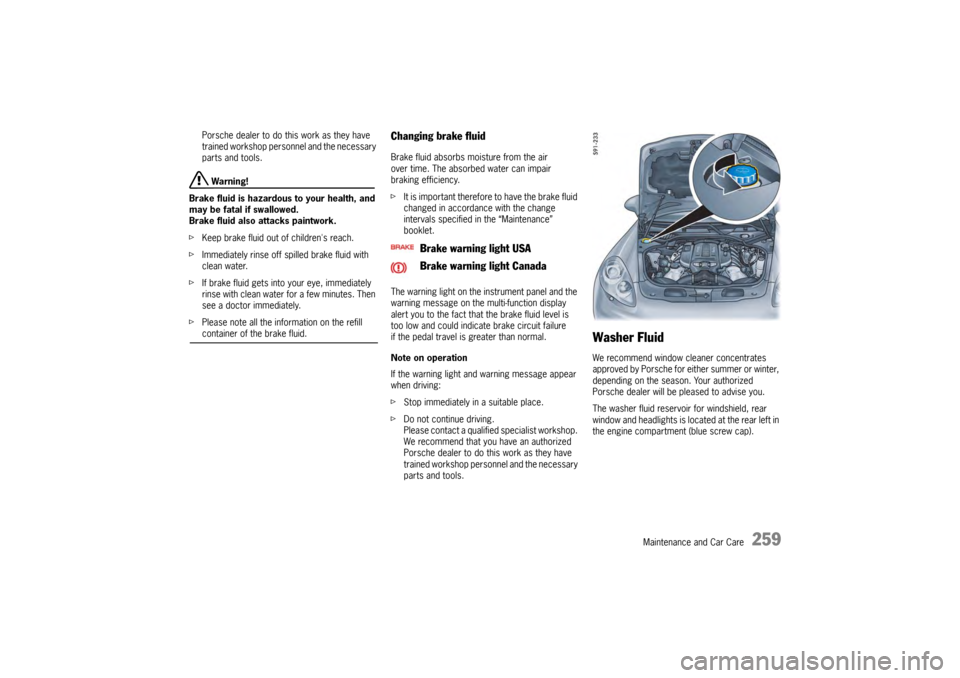
Maintenance and Car Care
259
Porsche dealer to do this work as they have
trained workshop personnel and the necessary
parts and tools. Warning!
Brake fluid is hazardous to your health, and
may be fatal if swallowed.
Brake fluid also attacks paintwork.
f Keep brake fluid out of children's reach.
f Immediately rinse off spilled brake fluid with
clean water.
f If brake fluid gets into your eye, immediately
rinse with clean water for a few minutes. Then
see a doctor immediately.
f Please note all the info rmation on the refill container of the brake fluid.
Changing brake fluidBrake fluid absorbs moisture from the air
over time. The absorbed water can impair
braking efficiency.
fIt is important therefore to have the brake fluid
changed in accordance with the change
intervals specified in the “Maintenance”
booklet.
The warning light on the instrument panel and the
warning message on the multi-function display
alert you to the fact that the brake fluid level is
too low and could indicate brake circuit failure
if the pedal travel is greater than normal.
Note on operation
If the warning light and warning message appear
when driving:
f Stop immediately in a suitable place.
f Do not continue driving.
Please contact a qualified specialist workshop.
We recommend that you have an authorized
Porsche dealer to do this work as they have
trained workshop personnel and the necessary
parts and tools.
Washer Fluid We recommend window cleaner concentrates
approved by Porsche for either summer or winter,
depending on the season. Your authorized
Porsche dealer will be pleased to advise you.
The washer fluid reservoir for windshield, rear
window and headlights is located at the rear left in
the engine compartment (blue screw cap).
Brake warning light USA
Brake warning light Canada
Page 262 of 343

260
Maintenance and Car Care
The warning light on the instrument panel and
the warning message on the multi-function display
alert you to the fact that the washer fluid level
is too low.
f
Add washer fluid at the next opportunity.
In this case, the remaining quantity is only approx.
1 litre. The maximum filling capacity is approx.
5.8USquarts (5.5liters).
Adding washer fluid
1. Open cap on washer fluid reservoir.
2. Add washer fluid.
3. Close cap carefully.
Power Steering
Warning!
Risk of accidents. When the engine is
stationary (e.g. when on tow) or the hydraulic
system fails, there is no power steering
assistance available.
Therefore, substantially more force will have
to be exerted to steer the vehicle.
f Exercise extreme care when your vehicle is
being towed.
f Have the fault corrected. Please contact a
qualified specialist workshop. We recommend
that you have an authorized Porsche dealer to
do this work as they have trained workshop personnel and the necessary parts and tools.
Regular checking of hydraulic fluid is part of
servicing.
The flow noise heard at full steering lock is design-
related and does not indicate a defect in the
steering system. Vehicles with Porsche Dynamic Chassis
Control (PDCC)
If the fluid level is too
low, the message “Check
steering oil level” will appe ar on the multi-function
display.
f Have the fluid level checked immediately.
f Please contact a qualified specialist workshop.
We recommend that you have an authorized
Porsche dealer to do this work as they have
trained workshop personnel and the necessary
parts and tools.
Warning light and warning
message
Page 263 of 343
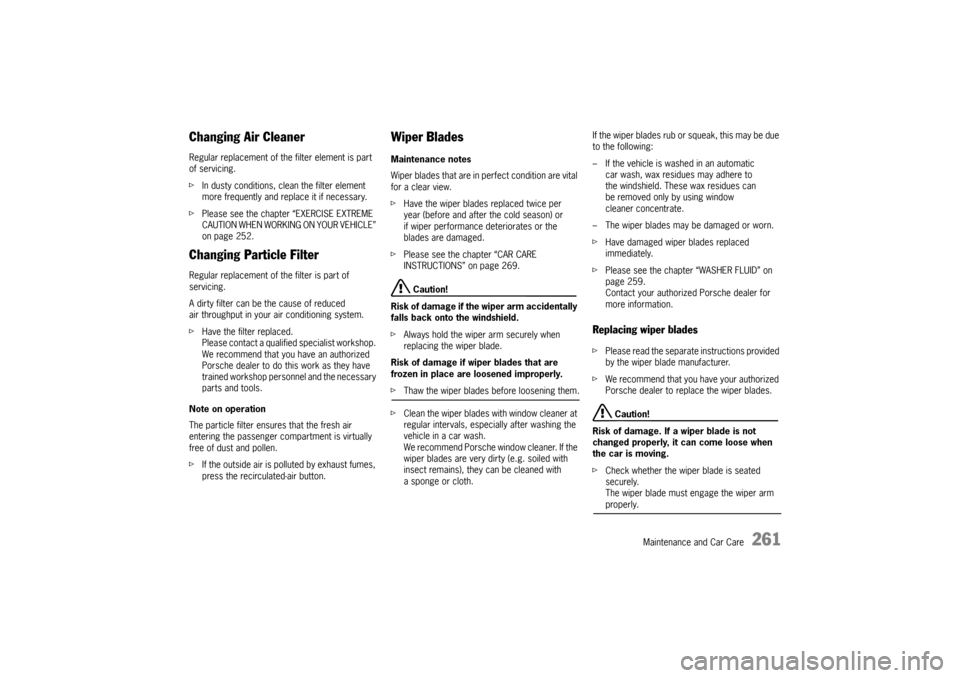
Maintenance and Car Care
261
Changing Air CleanerRegular replacement of the filter element is part
of servicing.
fIn dusty conditions, cl ean the filter element
more frequently and re place it if necessary.
f Please see the chapter “EXERCISE EXTREME
CAUTION WHEN WORKING ON YOUR VEHICLE”
on page 252.Changing Particle FilterRegular replacement of the filter is part of
servicing.
A dirty filter can be the cause of reduced
air throughput in your air conditioning system.
fHave the filter replaced.
Please contact a qualified specialist workshop.
We recommend that you have an authorized
Porsche dealer to do this work as they have
trained workshop personnel and the necessary
parts and tools.
Note on operation
The particle filter en sures that the fresh air
entering the passenger compartment is virtually
free of dust and pollen.
f If the outside air is polluted by exhaust fumes,
press the recirculated-air button.
Wiper BladesMaintenance notes
Wiper blades that are in perfect condition are vital
for a clear view.
fHave the wiper blades replaced twice per
year (before and after the cold season) or
if wiper performance deteriorates or the
blades are damaged.
f Please see the chapter “CAR CARE
INSTRUCTIONS” on page 269.
Caution!
Risk of damage if the wiper arm accidentally
falls back onto the windshield.
f Always hold the wiper arm securely when
replacing the wiper blade.
Risk of damage if wi per blades that are
frozen in place are loosened improperly.
f Thaw the wiper blades before loosening them.
f Clean the wiper blades with window cleaner at
regular intervals, especially after washing the
vehicle in a car wash.
We recommend Porsche window cleaner. If the
wiper blades are very dirty (e.g. soiled with
insect remains), they can be cleaned with
a sponge or cloth. If the wiper blades rub or
squeak, this may be due
to the following:
– If the vehicle is washed in an automatic car wash, wax residues may adhere to
the windshield. These wax residues can
be removed only by using window
cleaner concentrate.
– The wiper blades may be damaged or worn.
f Have damaged wiper blades replaced
immediately.
f Please see the chapter “WASHER FLUID” on
page 259.
Contact your authorize d Porsche dealer for
more information.
Replacing wiper bladesf Please read the separate instructions provided
by the wiper blade manufacturer.
f We recommend that you have your authorized
Porsche dealer to replace the wiper blades.
Caution!
Risk of damage. If a wiper blade is not
changed properly, it can come loose when
the car is moving.
f Check whether the wiper blade is seated
securely.
The wiper blade must engage the wiper arm properly.
Page 264 of 343
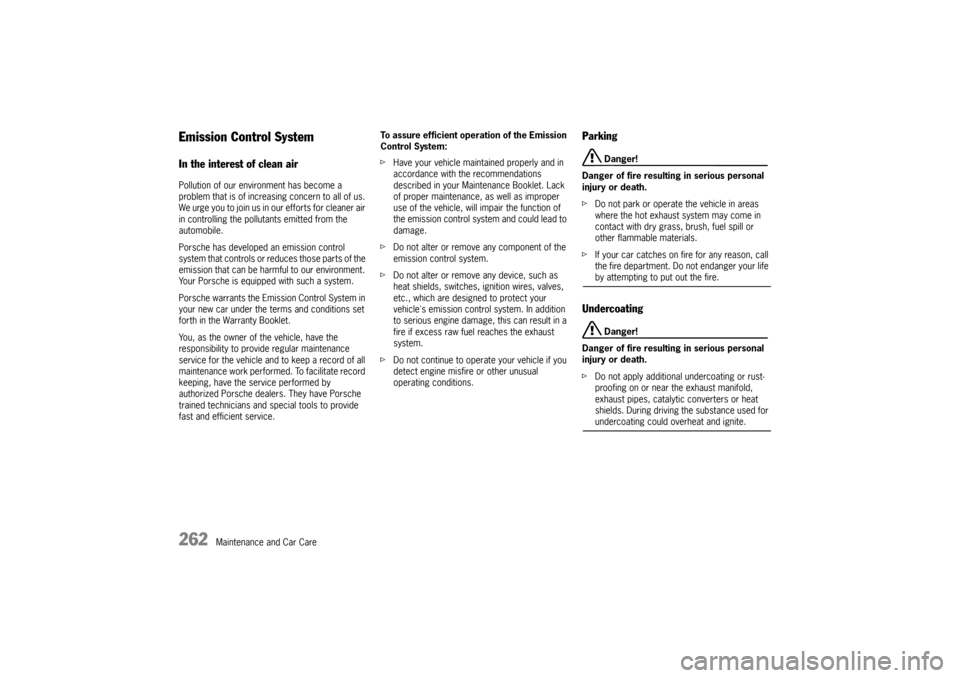
262
Maintenance and Car Care
Emission Control SystemIn the interest of clean airPollution of our environment has become a
problem that is of increasing concern to all of us.
We urge you to join us in our efforts for cleaner air
in controlling the pollutants emitted from the
automobile.
Porsche has developed an emission control
system that controls or reduces those parts of the
emission that can be harmful to our environment.
Your Porsche is equipped with such a system.
Porsche warrants the Emission Control System in
your new car under the terms and conditions set
forth in the Warranty Booklet.
You, as the owner of the vehicle, have the
responsibility to provide regular maintenance
service for the vehicle and to keep a record of all
maintenance work performed. To facilitate record
keeping, have the service performed by
authorized Porsche dealers. They have Porsche
trained technicians and special tools to provide
fast and efficient service.To assure efficient operation of the Emission
Control System:
f
Have your vehicle maintained properly and in
accordance with the recommendations
described in your Mai ntenance Booklet. Lack
of proper maintenance, as well as improper
use of the vehicle, will impair the function of
the emission control system and could lead to
damage.
f Do not alter or remove any component of the
emission control system.
f Do not alter or remove any device, such as
heat shields, switches, ignition wires, valves,
etc., which are designed to protect your
vehicle's emission control system. In addition
to serious engine damage, this can result in a
fire if excess raw fuel reaches the exhaust
system.
f Do not continue to operat e your vehicle if you
detect engine misfire or other unusual
operating conditions.
Parking
Danger!
Danger of fire resulting in serious personal
injury or death.
f Do not park or operate the vehicle in areas
where the hot exhaust system may come in
contact with dry grass, brush, fuel spill or
other flammable materials.
f If your car catches on fire for any reason, call
the fire department. Do not endanger your life by attempting to put out the fire.
Undercoating
Danger!
Danger of fire resulting in serious personal
injury or death.
f Do not apply additional undercoating or rust-
proofing on or near the exhaust manifold,
exhaust pipes, catalytic converters or heat
shields. During driving the substance used for undercoating could overheat and ignite.
Page 265 of 343

Maintenance and Car Care
263
How Emission Control WorksWhen an automobile engine is running, it uses
energy generated through the combustion of a
mixture of air and fuel. Depending on whether a
car is driven fast or slowly or whether the engine
is cold or hot, some of the fuel (hydrocarbons)
may not be burned completely, but may be
discharged into the engine crankcase or exhaust
system. Additonal hydrocarbons may enter the
atmosphere through evaporation of fuel from the
fuel tank. These hydrocarbons (HC), when
released into the air, co ntribute to undesirable
pollution.
In addition, carbon monoxide (CO) and oxides of
nitrogen (NOx) contribute to engine emissions.
They, too, are formed during the combustion
process and discharged into the exhaust system.
To reduce these pollutants, your Porsche is
equipped with a precisely calibrated fuel injection
system to assure a finely balanced air/fuel mixture
under all operating conditions.
Oxygen sensorThe oxygen sensor, installed in the exhaust pipe
continuously senses the oxygen content of the
exhaust and signals the information to an
electronic control unit. The control unit corrects
the air/fuel ratio, so the engine always receives an
accurately metered air/fuel mixture.Crankcase ventilationThrough crankcase ventilation, undesirable
emissions from the engine crankcase are not
permitted to reach the outside atmosphere. These
emissions are recirculated from the crankcase to
the air intake system. From here the emissions
mix with the intake air an d are later burned in the
engine.Catalytic convertersThe catalytic converters are efficient “clean-up”
devices built into the exhaust system of the
vehicle. The catalytic converters burn the
undesirable pollutants in the exhaust gas before it
is released into the atmosphere.
The exclusive use of unleaded fuel is
critically important for the life of the
catalytic converters. Therefore, only
unleaded fuel must be used. The catalytic converters will be damaged by:
– push or tow starting the vehicle
– misfiring of the engine
– turning off the ignition while the vehicle is
moving or
– driving until the fuel tank is completely empty
– by other unusual operating conditions.
f Do not continue to operate your vehicle under
these conditions, since raw fuel might reach
the catalytic converters. This could result in
overheating of the converters. Federal law
prohibits use of leaded fuel in this car.
Page 266 of 343

264
Maintenance and Car Care
Fuel EconomyFuel economy will vary depending on where,
when and how you drive, optional equipment
installed, and the general condition of your
car.
A car tuned to specifications and correctly
maintained, will help you to achieve optimal
fuel economy.
fHave your vehicle tuned to specifications. Air
cleaner should be dirt free to allow proper
engine “breathing”.
Battery should be fully charged.
Wheels should be properly aligned.
Tires should be inflated to the correct
pressure.
f Always monitor your fuel consumption.
f Drive smoothly, avoid abrupt changes in speed
as much as possible.
f Avoid jack rabbit starts and sudden stops.
f Do not drive longer than necessary in the lower
gears. Shifting into a higher gear early without
lugging the engine will help save fuel.
f Prolonged “warm up” idling wastes gas. Start
the vehicle just before you are ready to drive.
Accelerate slowly and smoothly.
f Switch off the engine if stationary for longer
periods.
f Any additional weight carried in the vehicle
reduces fuel economy. Always keep cargo to
a minimum and remove all unnecessary items. f
Organize your trips to take in several errands
in one trip.
f All electrical accessories contribute to
increased fuel consumption.
f Only switch on the air conditioning when
necessary.
f Do not drive with the Ro of Transport System
mounted unless you need it.
The EPA estimated miles per gallon (mpg) is
to be used for comparison purposes, actual
mileage may be different from the estimated
mpg, depending on your driving speed,
weather conditions and trip length. Your
actual highway mileage may be less than the
estimated mpg.
f Please observe all local and national speed
limits.
Operating Your Porsche in other
CountriesGovernment regulations in the United States and
Canada require that automobiles meet specific
emission regulations and safety standards.
Therefore, cars built for the U.S. and Canada differ
from vehicles sold in other countries.
If you plan to take your Porsche outside the
continental limits of the United States or Canada,
there is the possibility that
– unleaded fuel may not be available;
– unleaded fuel may have a considerably lower
octane rating. Excessi ve engine knock and
serious damage to both engine and catalytic
converters could result;
– service may be inadequate due to lack of proper service facilities, tools or diagnostic
equipment;
– replacement parts may not be available or very difficult to get.
Porsche cannot be responsible for the
mechanical damage that could result
because of inadequate fuel, service or parts
availability.
If you purchased your Porsche abroad and want to
bring it back home, be sure to find out about
shipping and forwarding requirements, as well as
current import and customs regulations.
Page 267 of 343

Maintenance and Car Care
265
FuelWhen the ignition is on, the fuel level is displayed
on the instrument panel.
fPlease see the chapter “FUEL GAUGE” on
page 111.
Warning!
Fuel is highly flammable and harmful to
health.
f Fire, open flame and smoking are prohibited
when handling fuel.
f Avoid contact with skin or clothing, since injury
to your skin may occur.
f Do not inhale fuel vapors, since they may make
you ill and possibly cause death if inhalation is
prolonged and occurs in a closed space.
To prevent damage to the emission control
system and engine:
f Never drive the tank dry.
f Avoid high cornering speeds after the warning lights have come on.
f Please see the chapter “FUEL ECONOMY” on
page 264. To avoid permanent damage
to the functionality of
the catalytic converters and oxygen sensors, use
unleaded fuel only.
The engine is designed to provide optimum
performance and fuel consumption if unleaded
premium fuel with 98 RON/88 MON is used.
If unleaded fuels with octane ratings of less than
98 RON/88 MON are used, the engine’s knock
control automatically adapts the ignition timing.
Porsche recommends that you use fuel with
at least 95 RON/85 MON in your vehicle.
The emission control system can be damaged in
various ways (e.g. fueling incorrectly, shortage of
fuel, tow-starting).
f Please see the chapter “HOW EMISSION
CONTROL WORKS” on page 263. Note on operation
Information on the fuel quality can normally
be found on the pump.
If this is not the case, ask a fuel station attendant.
If the recommended fuel
is not available, you
can also use unleaded regular fuel (91 RON/
82.5 MON) in an emergency.
However, this could reduce performance and
increase fuel consumption.
f Avoiding driving at full throttle.
In some countries the available fuel quality may
not meet requirements and can result in coking
around the inlet valve.
In this case, the fuel may be mixed with the
additive sold and recommended by Porsche after
consulting a authorized Porsche dealer.
Porsche part number 000 043 206 89.
f Observe the instructions and mixture ratios
stated on the container.
It is important that the service intervals,
particularly the oil change intervals, are
observed in accordance with the specifications
in the “Maintenance” booklet.
Page 268 of 343
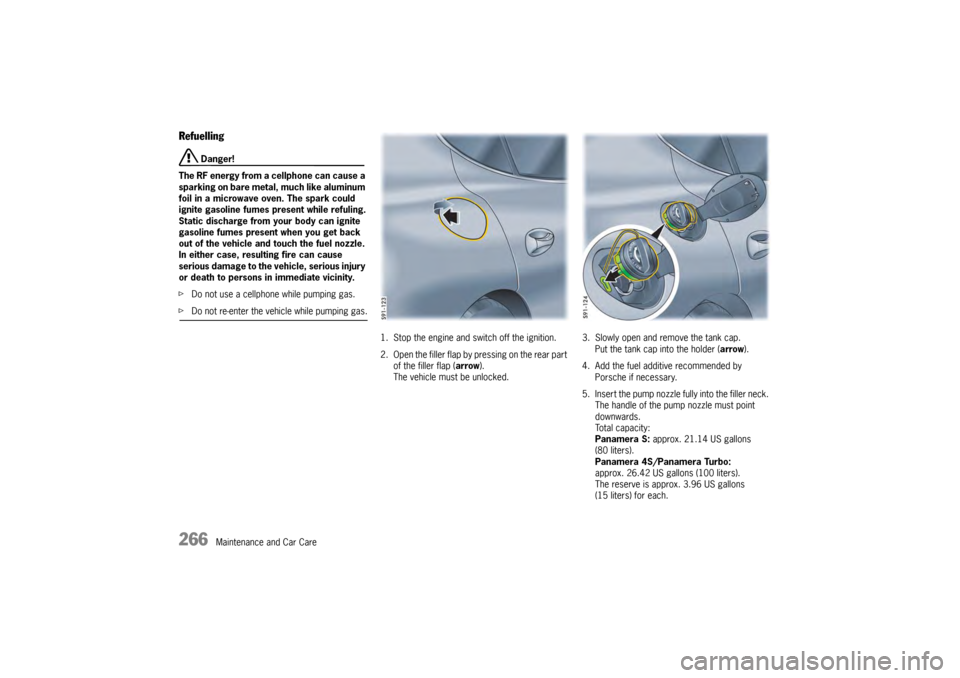
266
Maintenance and Car Care
Refuelling
Danger!
The RF energy from a cellphone can cause a
sparking on bare metal, much like aluminum
foil in a microwave oven. The spark could
ignite gasoline fumes present while refuling.
Static discharge from your body can ignite
gasoline fumes present when you get back
out of the vehicle and touch the fuel nozzle.
In either case, resulting fire can cause
serious damage to the vehicle, serious injury
or death to persons in immediate vicinity.
f Do not use a cellphone while pumping gas.
fDo not re-enter the vehicle while pumping gas.
1. Stop the engine and switch off the ignition.
2 . O p e n t h e f i l l e r f l a p b y p re s s i n g o n t h e re a r p a r t of the filler flap ( arrow).
The vehicle must be unlocked. 3. Slowly open and remove the tank cap.
Put the tank cap into the holder ( arrow).
4. Add the fuel additive recommended by Porsche if necessary.
5. Insert the pump nozzle fully into the filler neck.
The handle of the pump nozzle must point
downwards.
Total capacity:
Panamera S: approx. 21.14 US gallons
(80 liters).
Panamera 4S/Panamera Turbo:
approx. 26.42 US gallons (100 liters).
The reserve is approx. 3.96 US gallons
(15 liters) for each.
Page 269 of 343
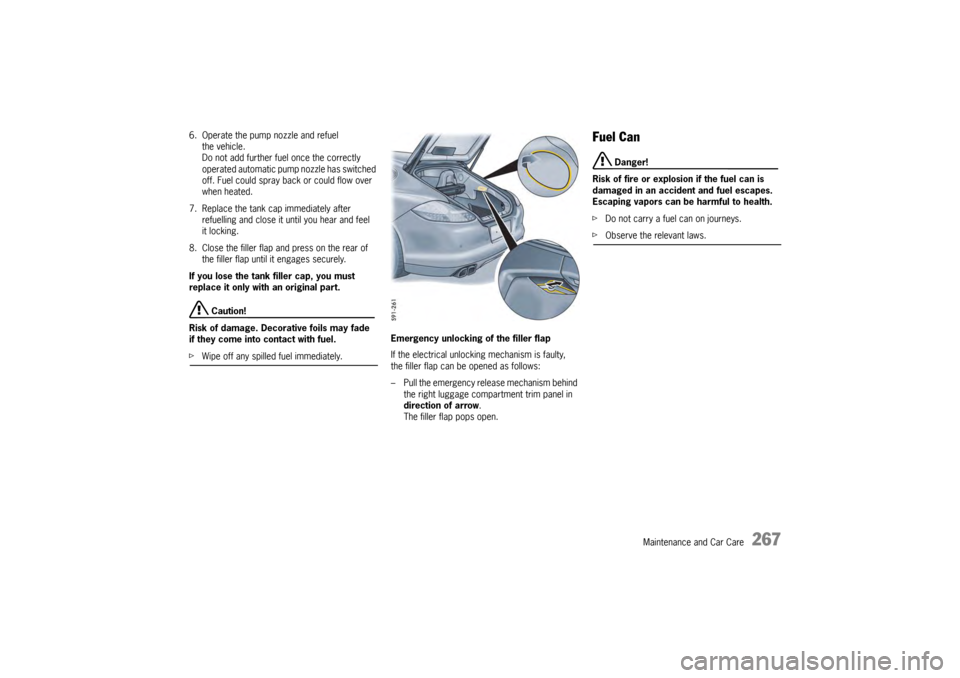
Maintenance and Car Care
267
6. Operate the pump nozzle and refuel the vehicle.
Do not add further fuel once the correctly
operated automatic pump nozzle has switched
off. Fuel could spray back or could flow over
when heated.
7. Replace the tank cap immediately after refuelling and close it until you hear and feel
it locking.
8. Close the filler flap and press on the rear of the filler flap until it engages securely.
If you lose the tank filler cap, you must
replace it only with an original part.
Caution!
Risk of damage. Decorative foils may fade
if they come into contact with fuel.
f Wipe off any spilled fuel immediately. Emergency unlocking of the filler flap
If the electrical unlocking mechanism is faulty,
the filler flap can be opened as follows:
– Pull the emergency release mechanism behind
the right luggage compartment trim panel in
direction of arrow .
The filler flap pops open.
Fuel Can
Danger!
Risk of fire or explosion if the fuel can is
damaged in an accident and fuel escapes.
Escaping vapors can be harmful to health.
f Do not carry a fuel can on journeys.
fObserve the relevant laws.
Page 270 of 343

268
Maintenance and Car Care
Fuel Recommendations Your Porsche is equipped with catalytic
converters and must use UNLEADED FUEL
ONLY .
Your engine is designed to provide optimum
performance and fuel economy using unleaded
premium fuel with an octane rating of 98 RON
(93 CLC or AKI) . Porsche therefore
recommends the use of these fuels in your
vehicle.
Porsche also recognizes that these fuels may not
always be available. Be assured that your vehicle
will operate properly on unleaded premium fuels
with octane numbers of at least 95 RON
(90 CLC or AKI) , since the engine’s “Electronic
Oktane™ knock control” will adapt the ignition
timing, if necessary.
It is important to observe the regular service
intervals, and particularly the oil change intervals,
specified in the “Maintenance” booklet.
T h e u s e o f U N L E A D E D F U E L O N LY i s c r i t i c a l l y
important to the life of the catalytic
converters. Deposits fr om leaded fuels will
ruin the converters and make them
ineffective as an emis sion control device.
Cars with catalytic converters have a smaller fuel
tank opening, and gas station pumps that
dispense unleaded fuel ha ve smaller nozzles. This
will prevent accidental pumping of leaded fuel into
cars with catalytic converters. Unleaded fuels may not be available outside the
continental U.S. and Canada. Therefore, we
recommend you do not take your car to areas or
countries where unleaded fuel may not be
available.
Octane ratings Octane rating indicates a fuel’s ability to resist
detonation. Therefore, buying the correct octane
gas is important to prevent engine “damage”.
The RON octane rating is based on the research
method. The CLC (U.S.
Cost of Living Council
octane rating) or AKI ( anti knock index) octane
rating usually displayed on U.S. fuel pumps is
calculated as research octane number plus motor
octane number, divided by 2, that is written as:
The CLC or AKI octane rating is usually lower than
the RON rating:
For example: 95 RON equals 90 CLC or AKI.
Fuels containing ethanolDo not use any fuels containing more than 10
percent ethanol by volume.
We recommend, however, to change to a different
fuel or station if any of the following problems
occur with your vehicle:
– Deterioration of driveability and performance.
– Substantially reduced fuel economy.
– Vapor lock and non-start problems, especially at high altitude or at high temperature.
– Engine malfunction or stalling.
RON+MON
2 R+M
2
or